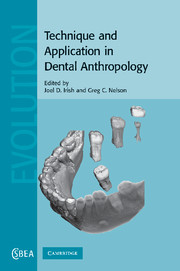Book contents
- Frontmatter
- Contents
- Contributors
- Acknowledgments
- Section I Context
- Section II Applications in assessing population health
- Section III Applied life and population history
- 9 Charting the chronology of developing dentitions
- 10 Dental age revisited
- 11 Primate dental topographic analysis and functional morphology
- 12 Forensic dental anthropology: issues and guidelines
- 13 Inter- and intra-specific variation in Pan tooth crown morphology: implications for Neandertal taxonomy
- 14 The quantitative genetic analysis of primate dental variation: history of the approach and prospects for the future
- Section IV Forefront of technique
- Index
- References
12 - Forensic dental anthropology: issues and guidelines
Published online by Cambridge University Press: 12 September 2009
- Frontmatter
- Contents
- Contributors
- Acknowledgments
- Section I Context
- Section II Applications in assessing population health
- Section III Applied life and population history
- 9 Charting the chronology of developing dentitions
- 10 Dental age revisited
- 11 Primate dental topographic analysis and functional morphology
- 12 Forensic dental anthropology: issues and guidelines
- 13 Inter- and intra-specific variation in Pan tooth crown morphology: implications for Neandertal taxonomy
- 14 The quantitative genetic analysis of primate dental variation: history of the approach and prospects for the future
- Section IV Forefront of technique
- Index
- References
Summary
Introduction
There is no doubt that over the years dentists around the world have positively identified a large percentage of the victims found at death scenes. They have done so by employing many tried-and-true dental procedures, including dissecting/resecting jaws from disfigured and decomposed victims, comparing ante- and postmortem dental radiographs, and studying bite marks inflicted on one person by another (Bowers, 2004; Bowers and Bell, 1995; Sopher, 1993; Stimson and Mertz, 1997). These and other procedures have been used for decades to positively identify recently deceased people. It would seem, then, that odontology is one area of forensic analysis that would not be in particular need of assistance from non-clinical personnel, i.e. biological anthropologists. However, forensic odontological studies proceed more efficiently when identifications are made on more or less complete dentitions. There are, of course, instances where teeth are significantly fragmented and commingled. With their training in the recovery and reconstruction of human remains, forensic dental anthropologists (odontoanthropologists in Wagner, 1997) are able to locate and rebuild dentitions and make them more amenable to study by the forensic dentist. Are forensic dentists capable of working in the absence of forensic dental anthropologists, even when confronted with commingled remains? Certainly, and many have (see Bowers and Bell, 1995; Morlang, 1997 for guidelines regarding forensic odontological mass disaster management). But, as I talk with forensic dentists, I have learned that most are willing to obtain assistance from dental anthropologists in difficult circumstances.
- Type
- Chapter
- Information
- Technique and Application in Dental Anthropology , pp. 266 - 292Publisher: Cambridge University PressPrint publication year: 2008
References
- 6
- Cited by



